
14 Nov
Measurement Guidelines for an Airline-Approved Pet Carrier
Given how close our pets are to us, it is no surprise we’ve tried to make every facet of their life as comfortable as ours. This is especially true for pet travel accessories; while you may not have much in the way of choice earlier, you can find a plethora of options when it comes to pet travel essentials.
Among these essentials is a pet travel carrier or crate. Much like any other product, you have plenty of options when it comes to the design, construction, and form factor of a pet crate. However, these differences are due to the different ways a pet crate is used worldwide, so it is important to know how you'll be using a pet crate before purchasing one.
For travel by road or to local destinations, there are plenty of options with the most defining aspect of such a crate being whether it is sized properly. But, for travel to overseas destinations, things are a little more complicated as crates need to comply with safety standards when in the sky. The International Air Transport Association (IATA) has issued a set of guidelines which airlines must cooperate with to ensure safety when travelling, so your shiny new pet crate or carrier will have to comply with these rules before you can transport your pet in it. Before you can do that though, you’ll need to measure your pet. Here’s how you can do this properly.
How to Measure Your Pet for a Crate
Before buying a crate, you need to know what crate size will be comfortable for your pet. Too big will be a waste of space, while too little will restrict airflow, so it is important to choose the correct size.
You’ll need four measurements to do this:
- A = Length of animal from nose to the root (bony tip) of their tail
- B = Height from ground to elbow joint
- C = Width across shoulders
- D = Height of the animal in a natural standing position from the floor to the top of the head or the ear tip

How to Calculate the Internal Volume of a Crate
Provided your pet isn’t a snub-nosed/flat-faced/brachycephalic breed, you can use these formulae to calculate the Length x Width x Height of your soon-to-be-bought pet crate. If your pet is a snub-nosed/flat-faced/brachycephalic breed, follow these formulae and choose one size larger than your measurements to ensure adequate ventilation.
- Length = A + ½B
- Width = C x 2
- Height = D + 3 inches
Construction of a Pet Crate
Comfort and safety go hand in hand when travelling with your pet; a pet crate needs to be comforting and welcoming but also strong and sturdy to deal with any nicks and bangs while en route. To help ensure that pet crates comply with the standards of air travel, IATA has issued a set of construction standards which make such crates far better for travel than a non-IATA accredited crate.
Here are the requirements for an IATA-approved pet crate:
- Kennels must be made of rigid plastic, solid wood, plywood, fibreglass, or metal. The roof and floor must be solid and leak-proof, and the door must constitute one entire end.
- There must be ventilation on four sides.
- No part of your pet can stick outside the crate.
- The openings of the ventilation holes must be no larger than 25 mm x 25 mm for dogs & 19 mm x 19 mm for cats.
- Every attachment hole in the top and bottom must be secured with metal bolts and nuts. Clips or twist locks are NOT permitted unless there is the addition of metal nuts & bolts for additional security.
- The interior must be entirely smooth, with no protrusions that could injure your pet or give them something to chew on.
- There must be two dishes/bowls secured to the inside of the kennel that are also accessible from the outside, to provide food and water in the event of a travel delay .
While these are not IATA-issued guidelines, these general tips will help make your journey smoother:
- The crate must have additional room for the pet to sit, stand, lie or turn around comfortably.
- The crate must be strong, sturdy and secured by a proper locking system.
- The crate must have LIVE ANIMAL stickers pasted on the top and sides in letters that are at least 1 inch tall.
- The crate must have continuous ventilation minimum on two sides (for domestic travel) and all four sides (in case of international travel)
- The crate must have LIVE ANIMAL stickers pasted on the top and sides in letters that are at least 1 inch tall.
- The crate must have LIVE ANIMAL stickers pasted on the top and sides in letters that are at least 1 inch tall.
- The crate must have its pet's details and owner's contact information.






AUTHOR’S BIO
Carry My Pet
Passionate pet enthusiasts and globetrotters, dedicated to easing furry friends' journeys worldwide. Penning tales of compassion at CarryMyPet, where every relocation is a tail-wagging adventure.